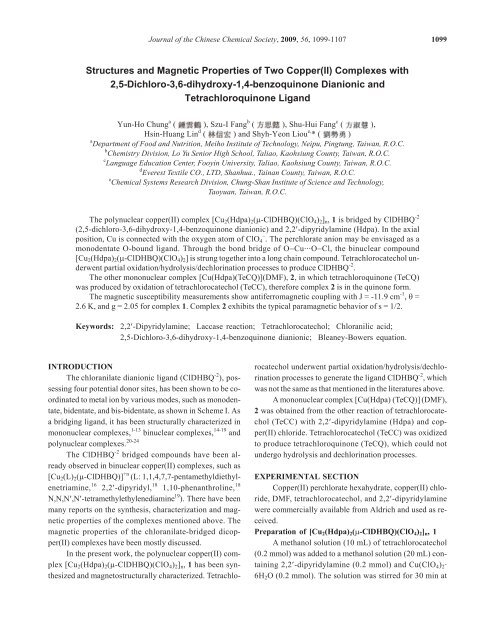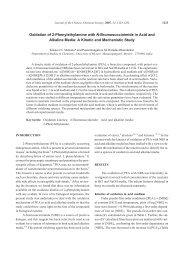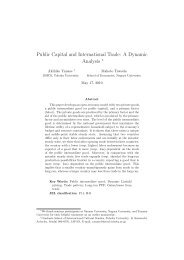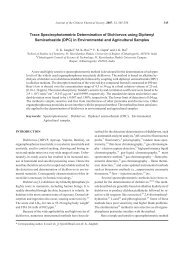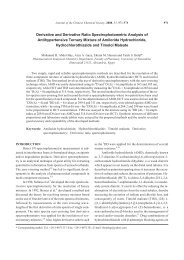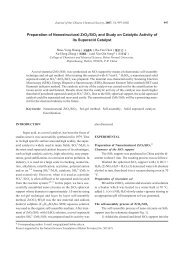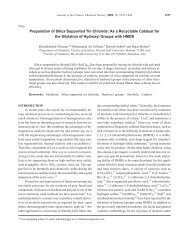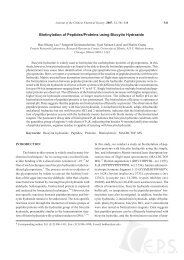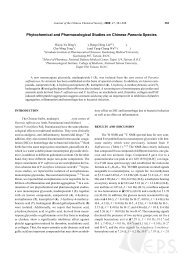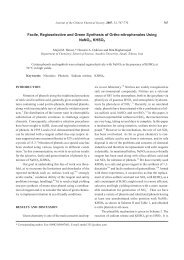Structures and Magnetic Properties of Two Copper(II) Complexes ...
Structures and Magnetic Properties of Two Copper(II) Complexes ...
Structures and Magnetic Properties of Two Copper(II) Complexes ...
Create successful ePaper yourself
Turn your PDF publications into a flip-book with our unique Google optimized e-Paper software.
<strong>Structures</strong> <strong>and</strong> <strong>Magnetic</strong> <strong>Properties</strong> <strong>of</strong> <strong>Two</strong> <strong>Copper</strong>(<strong>II</strong>) <strong>Complexes</strong> with<br />
2,5-Dichloro-3,6-dihydroxy-1,4-benzoquinone Dianionic <strong>and</strong><br />
Tetrachloroquinone Lig<strong>and</strong><br />
Yun-Ho Chung a ( ), Szu-I Fang b ( ), Shu-Hui Fang c ( ),<br />
Hsin-Huang Lin d ( ) <strong>and</strong> Shyh-Yeon Liou e, *( )<br />
a Department <strong>of</strong> Food <strong>and</strong> Nutrition, Meiho Institute <strong>of</strong> Technology, Neipu, Pingtung, Taiwan, R.O.C.<br />
b Chemistry Division, Lo Yu Senior High School, Taliao, Kaohsiung County, Taiwan, R.O.C.<br />
c Language Education Center, Fooyin University, Taliao, Kaohsiung County, Taiwan, R.O.C.<br />
d Everest Textile CO., LTD, Shanhua., Tainan County, Taiwan, R.O.C.<br />
e Chemical Systems Research Division, Chung-Shan Institute <strong>of</strong> Science <strong>and</strong> Technology,<br />
Taoyuan, Taiwan, R.O.C.<br />
The polynuclear copper(<strong>II</strong>) complex [Cu2(Hdpa)2(-ClDHBQ)(ClO4)2]n, 1 is bridged by ClDHBQ -2<br />
(2,5-dichloro-3,6-dihydroxy-1,4-benzoquinone dianionic) <strong>and</strong> 2,2-dipyridylamine (Hdpa). In the axial<br />
position, Cu is connected with the oxygen atom <strong>of</strong> ClO4 – . The perchlorate anion may be envisaged as a<br />
monodentate O-bound lig<strong>and</strong>. Through the bond bridge <strong>of</strong> OCu···OCl, the binuclear compound<br />
[Cu2(Hdpa)2(-ClDHBQ)(ClO4)2] is strung together into a long chain compound. Tetrachlorocatechol underwent<br />
partial oxidation/hydrolysis/dechlorination processes to produce ClDHBQ -2 .<br />
The other mononuclear complex [Cu(Hdpa)(TeCQ)](DMF), 2, in which tetrachloroquinone (TeCQ)<br />
was produced by oxidation <strong>of</strong> tetrachlorocatechol (TeCC), therefore complex 2 is in the quinone form.<br />
The magnetic susceptibility measurements show antiferromagnetic coupling with J = -11.9 cm -1 , =<br />
2.6 K, <strong>and</strong> g = 2.05 for complex 1. Complex 2 exhibits the typical paramagnetic behavior <strong>of</strong> s = 1/2.<br />
Keywords: 2,2-Dipyridylamine; Laccase reaction; Tetrachlorocatechol; Chloranilic acid;<br />
2,5-Dichloro-3,6-dihydroxy-1,4-benzoquinone dianionic; Bleaney-Bowers equation.<br />
INTRODUCTION<br />
The chloranilate dianionic lig<strong>and</strong> (ClDHBQ -2 ), possessing<br />
four potential donor sites, has been shown to be coordinated<br />
to metal ion by various modes, such as monodentate,<br />
bidentate, <strong>and</strong> bis-bidentate, as shown in Scheme I. As<br />
a bridging lig<strong>and</strong>, it has been structurally characterized in<br />
mononuclear complexes, 1-13 binuclear complexes, 14-19 <strong>and</strong><br />
polynuclear complexes. 20-24<br />
The ClDHBQ -2 bridged compounds have been already<br />
observed in binuclear copper(<strong>II</strong>) complexes, such as<br />
[Cu2(L)2(-ClDHBQ)] +n (L: 1,1,4,7,7-pentamethyldiethylenetriamine,<br />
16 2,2-dipyridyl, 18 1,10-phenanthroline, 18<br />
N,N,N,N-tetramethylethylenediamine 19 ). There have been<br />
many reports on the synthesis, characterization <strong>and</strong> magnetic<br />
properties <strong>of</strong> the complexes mentioned above. The<br />
magnetic properties <strong>of</strong> the chloranilate-bridged dicopper(<strong>II</strong>)<br />
complexes have been mostly discussed.<br />
In the present work, the polynuclear copper(<strong>II</strong>) complex<br />
[Cu2(Hdpa)2(-ClDHBQ)(ClO4)2]n, 1 has been synthesized<br />
<strong>and</strong> magnetostructurally characterized. Tetrachlo-<br />
Journal <strong>of</strong> the Chinese Chemical Society, 2009, 56, 1099-1107 1099<br />
rocatechol underwent partial oxidation/hydrolysis/dechlorination<br />
processes to generate the lig<strong>and</strong> ClDHBQ -2 ,which<br />
was not the same as that mentioned in the literatures above.<br />
A mononuclear complex [Cu(Hdpa) (TeCQ)] (DMF),<br />
2 was obtained from the other reaction <strong>of</strong> tetrachlorocatechol<br />
(TeCC) with 2,2-dipyridylamine (Hdpa) <strong>and</strong> copper(<strong>II</strong>)<br />
chloride. Tetrachlorocatechol (TeCC) was oxidized<br />
to produce tetrachloroquinone (TeCQ), which could not<br />
undergo hydrolysis <strong>and</strong> dechlorination processes.<br />
EXPERIMENTAL SECTION<br />
<strong>Copper</strong>(<strong>II</strong>) perchlorate hexahydrate, copper(<strong>II</strong>) chloride,<br />
DMF, tetrachlorocatechol, <strong>and</strong> 2,2-dipyridylamine<br />
were commercially available from Aldrich <strong>and</strong> used as received.<br />
Preparation <strong>of</strong> [Cu2(Hdpa)2(-ClDHBQ)(ClO4)2]n, 1<br />
A methanol solution (10 mL) <strong>of</strong> tetrachlorocatechol<br />
(0.2 mmol) was added to a methanol solution (20 mL) containing<br />
2,2-dipyridylamine (0.2 mmol) <strong>and</strong> Cu(ClO4)2·<br />
6H2O (0.2 mmol). The solution was stirred for 30 min at
1100 J. Chin. Chem. Soc., Vol. 56, No. 6, 2009 Chung et al.<br />
Scheme I<br />
The graph is by Susumu Kitagwa, Satoshi Kawata. 1,4-Dihydroxy-benzoquinone (H2C6H2O4) <strong>and</strong> its<br />
homologues can provide a variety <strong>of</strong> binding sites to metal cations. The dianionic form has five coordination<br />
modes, as shown in Scheme I.<br />
room temperature <strong>and</strong> then left st<strong>and</strong>ing at 25 C. After<br />
several days, green needle-shaped crystals suitable for single<br />
crystal X-ray analysis were formed. The crystals were<br />
collected by filtration <strong>and</strong> subsequently dried under vacuum.<br />
Anal. Calcd for C26H18Cl4Cu2N6O12: C, 35.67; H,<br />
2.07; N, 9.60%. Found: C, 35.25; H, 2.12; N, 9.43.<br />
Preparation <strong>of</strong> [Cu(Hdpa)(TeCQ)] (DMF), 2<br />
Under the protective atmosphere <strong>of</strong> nitrogen, the<br />
small amount <strong>of</strong> water from DMF was eliminated by reaction<br />
with silica gel. A DMF solution (20 mL) <strong>of</strong> 2,2-dipyridylamine<br />
(0.2 mmol) <strong>and</strong> copper(<strong>II</strong>) chloride (0.2 mmol)<br />
was added to a DMF solution (10 mL) <strong>of</strong> tetrachlorocatechol<br />
(0.2 mmol). The solution was stirred for 30 min<br />
under N2 at room temperature <strong>and</strong> then left st<strong>and</strong>ing at 25<br />
C. After several days, green rhombohedra-shaped crystals<br />
suitable for single crystal X-ray analysis were formed. The<br />
crystals were collected by filtration <strong>and</strong> subsequently dried<br />
under vacuum. Anal. Calcd for C19H16Cl4CuN4O3: C,<br />
41.21; H, 2.88; N, 10.12%. Found: C, 41.56; H, 2.32; N,<br />
10.43.<br />
Physical measurements<br />
Variable-temperature (2-300 K) magnetic susceptibility<br />
measurements under an external magnetic field <strong>of</strong> 1<br />
Tesla were performed with a SQUID magnetometer (MPMS7<br />
Quantum Design company). Diamagnetic calibrations are<br />
applied, using tabulated Pascal’s constants. 25<br />
X-ray Crystallography analysis<br />
Intensity data were collected at room temperature using<br />
a Siemens CCD diffractometer equipped with graphitemonochromated<br />
Mo-K radiation ( = 0.71073 Å). The<br />
structures were solved by direct <strong>and</strong> squares methods based<br />
on F 2 using the programs SHELXS-97 <strong>and</strong> SHELXL-97. 26<br />
Crystallographic data <strong>and</strong> refinement details for complexes<br />
1 <strong>and</strong> 2 are summarized in Table 1. Selected bond<br />
lengths <strong>and</strong> angles for complex 1 <strong>and</strong> 2 are listed in Table 2.<br />
RESULTS AND DISCUSSION<br />
Description <strong>of</strong> the crystal structures<br />
The structure <strong>of</strong> [Cu2(Hdpa)2(-ClDHBQ)(ClO4)2]n,<br />
1 is essentially made up [Cu2L2(-ClDHBQ)] +2 binuclear<br />
cations <strong>and</strong> two coordinated perchlorate anions. The chloranilate<br />
dianion serves as a bridging lig<strong>and</strong> between two<br />
copper centers. Each copper(<strong>II</strong>) ion is coordinated to two<br />
nitrogen atoms <strong>of</strong> one Hdpa <strong>and</strong> two oxygen atoms <strong>of</strong> one<br />
ClDHBQ. An ORTEP drawing with atom-numbering scheme
<strong>Two</strong> <strong>Copper</strong>(<strong>II</strong>) <strong>Complexes</strong> with ClDHBQ -2 <strong>and</strong> TeCQ Lig<strong>and</strong> J. Chin. Chem. Soc., Vol. 56, No. 6, 2009 1101<br />
Table 1. Crystallographic data <strong>and</strong> refinement details for complex 1 <strong>and</strong> complex 2<br />
Complex 1 Complex 2<br />
Empirical formula C26H18Cl4Cu2N6O12 C19H16Cl4CuN4O3 Formula weight 875.34 553.70<br />
Crystal system Monoclinic Orthorhombic<br />
Space group P2(1)/n P n 21 a<br />
a (Å) 7.2636(4) 7.2260(4)<br />
b (Å) 17.5366(10) 16.9040(10)<br />
c (Å) 12.7350(8) 18.5850(12)<br />
(deg) 90 90<br />
(deg) 98.487(1) 90<br />
(deg) 90 90<br />
Volume 1604.41(16) Å 3<br />
2270.1(2) Å 3<br />
Z 4 4<br />
Density (calculated) 1.812 Mg/m 3<br />
1.620 Mg/m 3<br />
Absorption coefficient 1.731 mm -1<br />
1.462 mm -1<br />
F(000) 876 1116<br />
Crystal size 0.30 0.15 0.15 mm 3<br />
for the complex 1 is shown in Fig. 1. Each Cu(<strong>II</strong>) ion has a<br />
square pyramidal lig<strong>and</strong> environment. The equatorial positions<br />
are occupied by four atoms: two N atoms from Hdpa<br />
(Cu(1)–N(1) = 1.954(3) Å <strong>and</strong> Cu(1)–N(3) = 1.967(3) Å),<br />
<strong>and</strong> two O atoms from -ClDHBQ (Cu(1)–O(11) =<br />
1.956(3) Å <strong>and</strong> Cu(1)–O(12) = 1.995(3) Å, see Table 2).<br />
The bond angles <strong>of</strong> N(1)–Cu(1)–N(3) <strong>and</strong> O(1)–Cu(1)–<br />
O(2) are 92.35(13) <strong>and</strong> 81.50(10), respectively. The apical<br />
position is occupied by bridging perchlorate anion.<br />
Through the bond bridge <strong>of</strong> O–Cu···O–Cl, the binuclear<br />
compound is strung together into a long chain compound<br />
[Cu2(Hdpa)2(-ClDHBQ)(ClO4)2]n, 1. The framework construction<br />
<strong>of</strong> complex 1 from 1D coordination polymer motifs<br />
is shown in Fig. 2. For the bridging perchlorate anion,<br />
the Cu–O distance at the apical position is 2.543 Å. It is obviously<br />
shorter than the Cu···O intermolecular distance <strong>of</strong><br />
2.602 Å on the opposite position (Table 2). The intramolecular<br />
distance Cu(1)···Cu(1A) <strong>of</strong> complex 1 is 7.69 Å.<br />
Compared with the other similar compounds, such as<br />
0.2 0.1 0.08 mm 3<br />
Theta range for data collection 1.99 to 28.30 3.02 to 25.10<br />
Index ranges -9 h 9, -22 k 23 -8 h 8, -18 k 20<br />
-15 l 16 -17 1 22<br />
Reflections collected 10492 12516<br />
Independent reflections 3840 [R(int) = 0.0341] 3840 [R(int) = 0.0341]<br />
Max. <strong>and</strong> min. transmission 0.97350 <strong>and</strong> 0.82323 0.9134 <strong>and</strong> 0.7742<br />
Refinement method Full-matrix least-squares on F 2<br />
Full-matrix least-squares on F 2<br />
Data/restraints/parameters 3840/0/226 3895/1/281<br />
Goodness-<strong>of</strong>-fit on F 2<br />
1.192 1.046<br />
Final R indices [I > 2sigma(I)] R1 = 0.0573, wR2 = 0.1294 R1 = 0.0698, wR2 = 0.1471<br />
R indices (all data) R1 = 0.0694, wR2 = 0.1347 R1 = 0.1343, wR2 = 0.1824<br />
Largest diff. peak <strong>and</strong> hole 1.092 <strong>and</strong> -0.731 e.Å -3<br />
0.407 <strong>and</strong> -0.358 e.Å -3<br />
[Cu2(bpy)2(ClDHBQ)](PF6)2·2CH3OH 18 <strong>and</strong> [Cu2(Me3tacn)2(ca)](ClO4)2,<br />
19 whose distances are 7.661 Å <strong>and</strong><br />
7.679 Å, respectively, the difference in the distance Cu(1)···<br />
Cu(1A) is not large at all.<br />
An ORTEP drawing with atom-numbering scheme<br />
for the complex [Cu(Hdpa) (TeCQ)] (DMF), 2 is shown in<br />
Fig. 3. The copper atom has a square planar geometry with<br />
two N atoms from Hdpa (Cu(1)–N(1) = 2.001(15) Å <strong>and</strong><br />
Cu(1)–N(2) 1.922(16) Å), <strong>and</strong> two O atoms from TeCQ<br />
(Cu(1)–O(1) = 1.917(14) Å <strong>and</strong> Cu(1)–O(2) = 1.921(11)<br />
Å, see Table 2). The bond angles <strong>of</strong> N(1)–Cu(1)–N(2) <strong>and</strong><br />
O(1)–Cu(1)–O(2) are 91.4(3) <strong>and</strong> 86.8(3), respectively.<br />
Complex 2 is in the o-quinone form as shown in<br />
Scheme <strong>II</strong>. The bond lengths <strong>of</strong> C(1)–O(1) <strong>and</strong> C(6)–O(2)<br />
are 1.43(2) Å <strong>and</strong> 1.22(2) Å, respectively. The average<br />
bond length for both is 1.325 Å, which is longer than that <strong>of</strong><br />
semiquinone (1.262 Å). The packing in the lattice <strong>of</strong> complex<br />
2 is shown in Fig. 4. There is a weak interaction between<br />
Namine in Hdpa <strong>and</strong> Cu in its neighboring molecule.
1102 J. Chin. Chem. Soc., Vol. 56, No. 6, 2009 Chung et al.<br />
Table 2. Selected bond lengths (Å) <strong>and</strong> angles (deg) for complex 1 <strong>and</strong> complex 2<br />
Complex 1<br />
Cu(1)-N(1) 1.954(3) Cu(1)-O(11) 1.956(3) Cu(1)-N(3) 1.967(3)<br />
Cu(1)-O(12) 1.995(3) N(2)-C(6) 1.374(5) N(2)-C(5) 1.380(5)<br />
C(12)-C(13A) 1.395(5) C(11)-C(12) 1.523(5) C(11)-C(13) 1.384(5)<br />
C(13A)-C(11A) 1.395(5) O(11)-C(11) 1.256(4) O(12)-C(12) 1.268(4)<br />
CuO(ClO4) 2.543 Å Cu···O(ClO4) 2.602 Å<br />
N(1)-Cu(1)-N(3) 92.35(13) O(12)-Cu(1)-N(3) 93.09(12)<br />
N(1)-Cu(1)-O(11) 93.71(12) O(11)-Cu(1)-O(12) 81.50(10)<br />
C(6)-N(2)-C(5) 131.5(3) C(13A)-C(12)-C(11) 119.7(3)<br />
(12)-C(13A)-C(11A) 119.7(3) C(13A)-C(11)-C(12) 120.5(3)<br />
O(11)-C(11)-C(12)<br />
Complex 2<br />
115.0(3) O(12)-C(12)-C(11) 114.4(3)<br />
Cu(1)-N(2) 1.922(16) Cu(1)-O(1) 1.917(14) Cu(1)-O(2) 1.921(11)<br />
Cu(1)-N(1) 2.001(15) O(1)-C(1) 1.43(2) O(2)-C(6) 1.22(2)<br />
C(1)-C(2) 1.38(2) C(3)-C(4) 1.377(11) C(4)-C(5) 1.43(3)<br />
C(5)-C(6) 1.44(3) Cl(1)-C(2) 1.790(18) Cl(2)-C(3) 1.734(19)<br />
Cl(3)-C(4) 1.723(15) Cl(4)-C(5) 1.65(2) N(3)-C(11) 1.31(3)<br />
N(3)-C(12) 1.47(3)<br />
N(2)-Cu(1)-O(1) 90.1(7) O(2)-Cu(1)-O(1) 86.8(3)<br />
N(2)-Cu(1)-N(1) 91.4(3) O(2)-Cu(1)-N(1) 91.6(6)<br />
C(1)-O(1)-Cu(1) 106.1(11) C(6)-O(2)-Cu(1) 111.8(12)<br />
C(1)-C(2)-C(3) 120.3(17) C(3)-C(4)-C(5) 122.4(18)<br />
C(4)-C(3)-C(2) 117.8(19) C(4)-C(5)-C(6) 120.3(18)<br />
C(1)-C(6)-C(5) 114(2)<br />
The length <strong>of</strong> Namine......Cu is 3.558 Å.<br />
Laccase-like reaction<br />
In the preparation <strong>of</strong> complex 1, tetrachlorocatechol<br />
undergoes partial oxidation/hydrolysis/dechlorination processes<br />
to produce ClDHBQ -2 . It is very similar to the bio-<br />
catalyst reaction <strong>of</strong> laccase. Laccases are found in plants,<br />
insects <strong>and</strong> bacteria, but the most important source <strong>of</strong> this<br />
enzyme is from fungi. Therefore, laccases produced by<br />
white-rot fungi can act as a biocatalyst to help treat the<br />
toxic organopollutants in waste water. 28-31 The degradation<br />
<strong>of</strong> tetrachloroguaiacol (TeCG) or tetrachlorocatechol<br />
Fig. 1. An ORTEP drawing with atom-numbering scheme for the complex [Cu2(Hdpa)2(-ClDHBQ)(ClO4)2]n, 1.
<strong>Two</strong> <strong>Copper</strong>(<strong>II</strong>) <strong>Complexes</strong> with ClDHBQ -2 <strong>and</strong> TeCQ Lig<strong>and</strong> J. Chin. Chem. Soc., Vol. 56, No. 6, 2009 1103<br />
(TeCC) in waste water can then be achieved. Through dechlorination,<br />
TeCG or TeCC can be turned into ClDHBQ -2 .<br />
In the experiment <strong>of</strong> Iimura et al., 31 water was used as a nucleophile,<br />
which was vital element for producing dechlo-<br />
Fig. 2. The framework construction <strong>of</strong> [Cu2(Hdpa)2(-<br />
ClDHBQ)(ClO4)2]n, 1 from 1D.<br />
rination. The laccase-catalyzed dechlorination is not caused<br />
by the oxidative coupling, but by nucleophilic substitution<br />
in which Cl is released by water from cation radicals generated<br />
by the laccase.<br />
According to the above experiment <strong>of</strong> Iimura et al.,<br />
our experiment about the generation <strong>of</strong> [Cu2(Hdpa)2(-<br />
ClDHBQ)(ClO4)2]n, 1 can be rationally confirmed. The<br />
tetrachlorocatechol (TeCC) is first oxidized by Cu +2 ion to<br />
obtain the phenoxy cation intermediate. Subsequently, the<br />
nucleophilic attack <strong>of</strong> water in the phenoxy cation position,<br />
<strong>and</strong> then repels Cl – to form p-benzoquinone. The reaction<br />
mechanism is shown in Scheme <strong>II</strong>I.<br />
<strong>Magnetic</strong> properties<br />
Variable-temperature magnetic studies were performed<br />
on dried, powdered samples <strong>of</strong> complex 1 in the<br />
temperature range 2-300 K. The magnetism <strong>of</strong> complex 1 is<br />
worth mentioning. In the analysis, we first fitted the data <strong>of</strong><br />
complex by the empirical expression proposed by Hatfield<br />
for alternating chains, but the result was not good. It has<br />
been assumed that the magnetic exchange coupling <strong>of</strong><br />
Cu–O–Cl–O···Cu is very small or reaching zero. Complex<br />
1 is mainly a Cu(<strong>II</strong>) binuclear compound. The magnetic<br />
data were fitted by using the Bleaney-Bowers equation, as<br />
shown below.<br />
m =[N 2 g 2 /3k(T – )][1 + 1/3 exp(-2J/kT)] 1 (1 – )<br />
+(N 2 g 2 /4kT)+N<br />
Fig. 3. An ORTEP drawing with atom-numbering scheme for the complex [Cu(Hdpa) (TeCQ)] (DMF), 2.
1104 J. Chin. Chem. Soc., Vol. 56, No. 6, 2009 Chung et al.<br />
Scheme <strong>II</strong><br />
The graph is by Jorge H. Rodriguez, Daniel E. Wheeler, <strong>and</strong> James K. McCusker.<br />
Semiquinone is the one-electron reduced form <strong>of</strong> quinone <strong>and</strong> which can be further reduced<br />
by one electron to catechol.<br />
where N is Avogadro’s number, g is the Zeeman splitting<br />
factor, is the Bohr magnetion, k is the Boltzmann constant,<br />
J is the exchange integral, T is the absolute temperature,<br />
N is the temperature-independent paramagnetism<br />
<strong>and</strong> is the molar fraction <strong>of</strong> monomeric impurity.<br />
Plots <strong>of</strong> mT versus T for complex [Cu2(Hdpa)2(-<br />
ClDHBQ)(ClO4)2]n 1, <strong>and</strong> the best theoretical fits (solid<br />
line) for complex 1 are shown in Fig. 5. A very good fit was<br />
achieved with J = -11.9 cm -1 , = 2.6 K, g = 2.05, = 0.015.<br />
Complex 1 shows antiferromagnetic interactions.<br />
According to literature review, 32 the binuclear <strong>of</strong> copper(<strong>II</strong>)<br />
compounds with C6X2O4-bridged to be possible to<br />
be divided into four types. The compounds <strong>of</strong> type I with<br />
tridentate end-cap lig<strong>and</strong> show a weak magnetic interaction<br />
(For example: [Cu2(Me2dien)2(ca)](BPh4)2,J=0.1cm -1 ). 16<br />
The compounds <strong>of</strong> type <strong>II</strong> with tridentate end-cap lig<strong>and</strong><br />
demonstrate that the J value is fell into the range from -2 to<br />
-5 cm -1 .(Forexample:[Cu2(dpt)2(dhbq)] (BPh4)2, J=-4.6<br />
cm -1 ). 16 Cupric ions in the structures <strong>of</strong> both types are described<br />
as the intermediates between a trigonal bipyramidal<br />
(tbp) <strong>and</strong> a square pyramidal(sp). As a result <strong>of</strong> the low<br />
symmetry <strong>of</strong> cupric ion, the basic plane <strong>and</strong> the plane <strong>of</strong> the<br />
bridging network <strong>of</strong> the cupric ion are non-coplanar. Such<br />
distortions <strong>of</strong> the geomeyry <strong>of</strong> cupric ion must be unfavorable<br />
for spin coupling through C6X2O4-bridged plane.<br />
For the compounds <strong>of</strong> the type <strong>II</strong>I, a significant antiferromagnetic<br />
interaction is shown. The range <strong>of</strong> the values<br />
for spin coupling are from -8 cm -1 to -13 cm -1 .(Forexample:<br />
[Cu2(bpy)2(ca)](PF6)2·2CH3OH, J = -11.7 cm -1 ). 18 For<br />
the compounds <strong>of</strong> the last class, type IV, unexpectedly<br />
strong antiferromagnetic interactions are reported based on<br />
the magnetic data in the limited temperature range (100-<br />
Fig. 4. The packing in the lattice <strong>of</strong> [Cu(Hdpa) (TeCQ)] (DMF), 2. There is a weak interreaction between Namine in Hdpa <strong>and</strong><br />
Cu in its neighboring molecule. The length <strong>of</strong> Namine......Cu is 3.558 Å.
<strong>Two</strong> <strong>Copper</strong>(<strong>II</strong>) <strong>Complexes</strong> with ClDHBQ -2 <strong>and</strong> TeCQ Lig<strong>and</strong> J. Chin. Chem. Soc., Vol. 56, No. 6, 2009 1105<br />
Scheme <strong>II</strong>I<br />
The graph is partially structured by Y. Iimura, P. Hartikainen,<br />
<strong>and</strong> K. Tatsumi. The tetrachlorocatechol (TeCC) is first oxidized<br />
by Cu +2 ion to obtain the phenoxy cation intermediate.<br />
Subsequently, the nucleophilic attack <strong>of</strong> water in the phenoxy<br />
cation position, <strong>and</strong> then repels Cl – to form p-benzoquinone.<br />
The reaction mechanism is shown in Scheme <strong>II</strong>I.<br />
300 K). (For example: [Cu2(Me3tacn)2(ca)] (ClO4)2,J=-30<br />
cm -1 ). 33 <strong>Two</strong> types <strong>of</strong> coordination geometries about each<br />
copper atom are a square pyramidal or a square planar geometry<br />
with two N atoms <strong>of</strong> the lig<strong>and</strong> <strong>and</strong> two O atoms <strong>of</strong><br />
C6X2O4-bridged plane. The basic plane <strong>of</strong> cupric ion <strong>and</strong><br />
the plane <strong>of</strong> the bridging network are almost coplanar. The<br />
Fig. 6. The edge view <strong>of</strong> [Cu2(Hdpa)2(-ClDHBQ)] +2 , 1.<br />
oxygen’s 2p orbital <strong>and</strong> the dx 2 -y 2 orbital <strong>of</strong> the copper<br />
ion’s equatorial plane overlapped in some parts <strong>of</strong> the effective<br />
orbital. However, because <strong>of</strong> the coplanarity, it will<br />
increase the overlapp <strong>of</strong> the magnetic orbital. Accordingly,<br />
through this exchange pathway, it shows weak antiferromagnetic<br />
exchange coupling.<br />
For complex 1, the chloranilate <strong>and</strong> the copper basal<br />
planes in the dinuclear units are almost coplanar. The dihedral<br />
angle O(1)···O(2) <strong>of</strong> coplanarity between the chloranilate<br />
<strong>and</strong> the copper basal planes is 8.6, as shown in<br />
Fig. 6 <strong>and</strong> Table 3. Compared with the other compounds,<br />
such as [Cu2(bpy)2(ClDHBQ)](PF6)2·2CH3OH 18 <strong>and</strong> [Cu2-<br />
(Me3-tacn)2(ca)](ClO4)2, 19 whose dihedral angles O(1)···<br />
O(2) are 10.1 <strong>and</strong> 6, respectively. These results are clearly<br />
shown in Table 3. The smaller the dihedral angle O(1)···<br />
O(2), the greater the coplanarity, <strong>and</strong> the greater the coplanarity,<br />
the bigger the spin-coupling constant (J).<br />
Complex 2 is Cu(<strong>II</strong>) mononuclear. In terms <strong>of</strong> the<br />
Fig. 5. Plots <strong>of</strong> mT versus T for complex [Cu2-<br />
(Hdpa)2(-ClDHBQ)(ClO4)2]n, 1, the solid line<br />
is the best theoretical fit.
1106 J. Chin. Chem. Soc., Vol. 56, No. 6, 2009 Chung et al.<br />
Table 3. Comparison <strong>of</strong> the dihedral angle O(1)O(2) <strong>of</strong> coplanarity between the<br />
chloranilate <strong>and</strong> the copper basal planes with the other compounds<br />
Compounds<br />
Dihedeal Angles<br />
O(1)···O(2)<br />
J(cm -1 ) References<br />
[Cu2(Me3-tacn) 2(ca)](ClO4) 2 6 -12.3 (19)<br />
[Cu2(bpy) 2(ClDHBQ)](PF6) 2·2CH2OH 10.1 -11.7 (18)<br />
[Cu2(Hdpa) 2(-ClDHBQ)(ClO4) 2] n 8.6 -11.9<br />
magnetic behavior <strong>of</strong> complex 2, mT keeps the expect<br />
value, <strong>and</strong> it is almost linear according to the graph <strong>of</strong> mT<br />
vs. T. Also, when the fit analysis is proceeded using the Curie-Weiss<br />
Model, the -values are very small. This is indicative<br />
<strong>of</strong> the typical paramagnetic behavior <strong>of</strong> unpaired electrons.<br />
SUMMARY<br />
In an aqueous environment, tetrachlorocatechol undergoes<br />
partial oxidation/hydrolysis/dechlorination processes<br />
to generate a chloranilate di-anion form, <strong>and</strong> complex<br />
1 will then be made. This reaction is similar to the<br />
laccase reaction. For complex 1, the dihedral angle O(1) …<br />
O(2) <strong>of</strong> coplanarity between the chloranilate <strong>and</strong> the copper<br />
basal planes is 8.6. The magnetic data were fitted by<br />
using the Bleaney-Bowers equation. A very good fit was<br />
achieved with J = -11.9 cm -1 , = 2.6 K, g = 2.05, = 0.015.<br />
Complex 1 shows antiferromagnetic interactions. Complex<br />
2 is Cu(<strong>II</strong>) mononuclear <strong>and</strong> in the o-quinone form, which<br />
exhibits the typical paramagnetic behavior <strong>of</strong> unpaired<br />
electrons. Using laccase produced by white-rot fungi to<br />
treat the toxic organopollutants in waste water is natural<br />
method for the decontamination <strong>of</strong> waste water. The question<br />
<strong>of</strong> whether complex chemicals can be used to imitate<br />
the laccase reaction to quicken the speed <strong>of</strong> treating waste<br />
water is worth studying <strong>and</strong> being explored. Furthermore,<br />
chloranillic acid, H2CA, is a fine coordination lig<strong>and</strong>, <strong>and</strong><br />
most papers mentioned using it directly as a coordination<br />
lig<strong>and</strong>. This paper is the first one to report on turning tetrachlorocatechol<br />
(TeCC) into chloranilic acid (H2CA), <strong>and</strong><br />
furthermore, the formation <strong>of</strong> the coordination lig<strong>and</strong>.<br />
SUPPLEMENTARY MATERIAL<br />
Crystallographic data for the structural analysis have<br />
been deposited at the Cambridge Crystallographic Data<br />
Centre <strong>and</strong> allocated the deposition numbers Complex (1)<br />
CCDC 265619 <strong>and</strong> Complex (2) CCDC 265618. Copies <strong>of</strong><br />
the data can be obtained, free <strong>of</strong> charge, on application to<br />
CCDC, 12 Union Road, Cambridge CB2 1EZ, UK [fax:<br />
+44(0)-1223-336033 or e-mail: deposit@ccdc.cam.ac.uk].<br />
ACKNOWLEDGEMENT<br />
This work was supported by the Department <strong>of</strong> Food<br />
<strong>and</strong> Nutrition, Meiho Institute <strong>of</strong> Technology.<br />
Received May 12, 2009.<br />
REFERENCES<br />
1. Shuncheng, L.; Shahid, N. S.; Jon, Z. Inorg. Chem. 1988, 27,<br />
3064.<br />
2. Shuncheng, L.; Shahid, N. S.; Jon, Z. Inorg. Chem. 1988, 28,<br />
723.<br />
3. Krasochka, O. N.; Avilov, V. A.; Otovmyan, L. O. Zh.<br />
Struckt. Khim. 1974, 15, 1140.<br />
4. Johnston, R. F.; Sen Gupta, P. K.; Ossain, M. B.; van der<br />
Helm, R.; Jeong, W.; Holwerda, R. A. Acta. Crystallogr.<br />
1990, C46, 1796.<br />
5. Johnston, R. F.; Veer, D. G. V. D.; Holwerda, R. A. J. Cryst.<br />
Spectrose. Res. 1992, 22, 755.<br />
6. Andrew,J.B.;Bruce,R.W.;Robert,A.H. Inorg. Chem.<br />
1995, 34, 622.<br />
7. Burzlaff, H.; Lange, J.; Spengler, R.; Karayannis, M.;<br />
Veltsistas, P. Acta. Crystallogr. 1995, C51, 190.<br />
8. Bram, A.; Bruederl, G.; Burzlaff, H.; Lange, J.; Rothammel,<br />
W.; Spengler, R.; Karayannis, M.; Veltsistas, P. Acta. Crystallogr.<br />
1994, C50, 178.<br />
9. Abrahams, B.; Hoskins, B.; Robson, R. Acta. Crystallogr.<br />
1996, C52, 2766.<br />
10. Decurtins, S.; Schmalle, H.; Schneuwly, P.; Zheng, L. Acta.<br />
Crystallogr. 1996, C52, 561.<br />
11. Zheng, L.; Schmalle, H.; Ferlay, S.; Decurtins, S. Acta.<br />
Crystallogr. 1998, C54, 1578.<br />
12. Krasochka, O. N.; Avilov, V. A.; Otovmyan, L. O. Zh.<br />
Struckt. Khim. 1974, 15, 1140.<br />
13. Abrahams, B. F.; Lu, K. D.; Moubaraki, B.; Murray, K. S.;<br />
Robson, R. J. Chem. Soc. Dalton Trans. 2000, 1793.<br />
14. Andrea, D.; Dante, G.; Luca, P.; Umberto, R. Inorg. Chem.<br />
1991, 30, 2589.<br />
15. Shaikh, S. N.; Zubieta, J. Inorg. Chim. Acta.1988, 146, 149.<br />
16. Pierpont, C. G.; Francesconi, L. C.; Hendrickson, D. N.
<strong>Two</strong> <strong>Copper</strong>(<strong>II</strong>) <strong>Complexes</strong> with ClDHBQ -2 <strong>and</strong> TeCQ Lig<strong>and</strong> J. Chin. Chem. Soc., Vol. 56, No. 6, 2009 1107<br />
Inorg. Chem. 1977, 16, 2367.<br />
17. Casas, J. M.; Falvello, L. R.; Forniés, J.; Mannsilla, G.;<br />
Martín, A. Polyhedron 1999, 18, 403.<br />
18. Fujii, C.; Minoru, M.; Kodera, M.; Motoda, K. I.; Ohba, M.;<br />
Matsumoto, N.; Okawa, H. Polyhedron 1994, 13, 933.<br />
19. Tinti, F.; Verdaguer, M.; Kahn, O.; Savariault, J. M. Inorg.<br />
Chem. 1987, 26, 2380.<br />
20. Kawata, S.; Kitagawa, S.; Kumagai, H.; Kudo, C.; Kamesaki,<br />
H.; Ishiyama, T.; Suzuki, R.; Kondo, M.; Katada, M. Inorg.<br />
Chem. 1996, 35, 4449.<br />
21. Decurtins, S.; Schmalle, H. W.; Zheng, L.-M.; Ensling, J.<br />
Inorg. Chim. Acta. 1996, 244, 165.<br />
22. Zheng, L.-M.; Schmalle, H. W.; Huber, R.; Decurtins, S.<br />
Polyhedron 1996, 15, 4399.<br />
23. Papadimitriou, C.; Veltsistas, P.; Marek, J.; Novosad, J.;<br />
Slawin, A. M. Z.; Woollins, J. D. Inorg. Chem. Commu.<br />
1998, 1, 418.<br />
24. Kawahara, M.; Kabir, M. K.; Yamada, K.; Adachi, K.;<br />
Kumagai, H.; Narumi, Y.; Kindo, K.; Kitagawa, S.; Kawata,<br />
S. Inorg. Chem. 2004, 43, 92.<br />
25. (a) Kahn, O. Molecular Magnetism; VCH: New York, 1993.<br />
(b) Drillon, M. M. Magnetism: Molecular to Materials <strong>II</strong>;<br />
Wiley-VCH: Weinheim, 2001.<br />
26. (a) Charlot, M. F.; Jeannin, S.; Jeannin, Y.; Kahn, O.;<br />
Lucrece-Abaul, J.; Martin-Frere, J. Inorg. Chem. 1979, 18,<br />
1675. (b) Charlot, M. F.; Kahn, O.; Jeannin, S.; Jeannin, Y.<br />
Inorg. Chem.1980, 19, 1410.<br />
27. Andersen,E.K. Acta. Crystallogr. 1967, 22, 188.<br />
28. Fetzner, S.; Lingens, F. Microbiol. Rev. 1994, 58, 641.<br />
29. Häggblom, M. M. FEMS. Microbiol. Rev. 1992, 103, 29.<br />
30. Mohn, W. W. Microbiol. Rev. 1992, 56, 482.<br />
31. Iimura, Y.; Hartikainen, P.; Tatsumi, K. App. Microbiol.<br />
Biotechnol. 1996, 45, 34.<br />
32. Kitagawa, S.; Kawata, S. Coord. Chem. Rev. 2002, 224,11.<br />
33. Chaudhuri, P.; Oder, K. J. Chem. Soc. Dalton Trans. 1990,<br />
1597.


